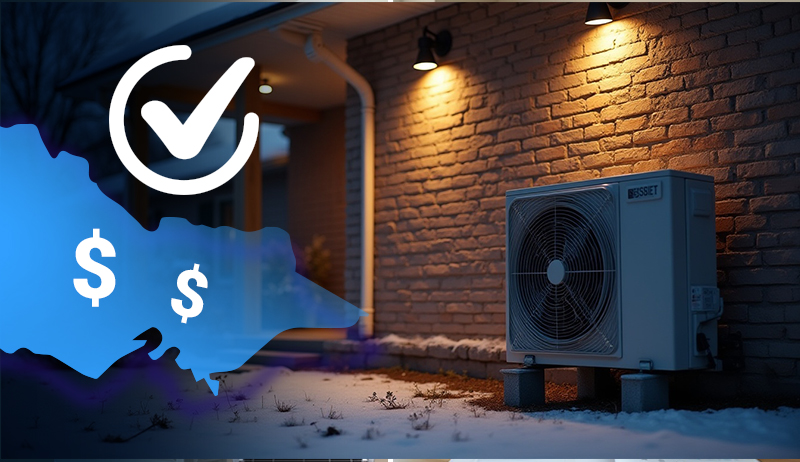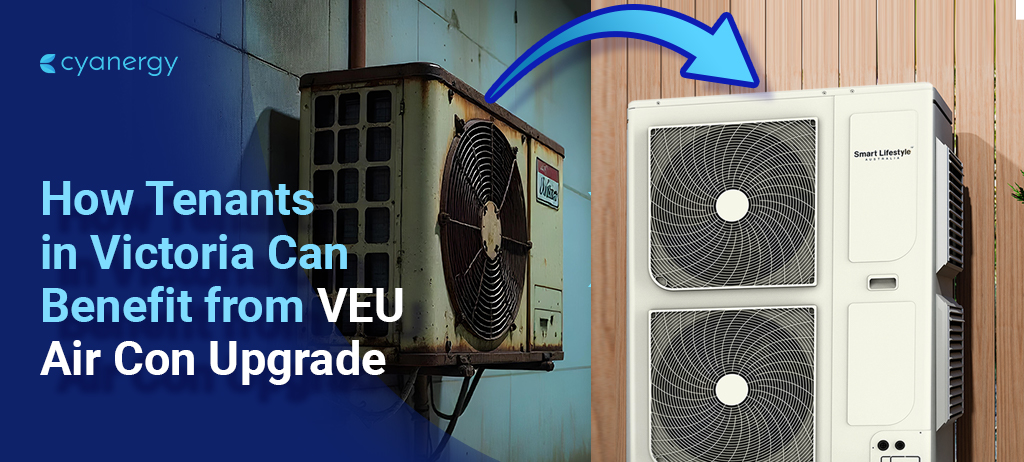Sometimes upgrading your home’s heating or cooling system can feel like navigating a maze.
However, with exciting incentives like the “ducted aircon rebate VIC” and schemes comparing “split vs ducted rebate,” it’s worth conducting a thorough analysis before making a purchase.
Therefore, in this blog, we’ll explore three major air conditioning types: ducted, single-split, and multi-split, sometimes called multi-head, and break down which might be best for you, especially under the VEU programme in Victoria.
Here, we’ll also cover pros & cons, cost & rebate implications, efficiency & zoning, suitable house types, and real-world case comparisons.
So, for further details, tag along!
In this blog post:
- Victoria's Air Conditioning System: Ducted, Split, & Multi Split!
- Are VEU Rebates Worth It? | Cost Comparisons & Rebate Benefits
- Cost Analysis: What You Pay vs Rebate Value!
- Factors That Influence the VEU Air Conditioner Rebate
- Maximising Aircon Efficiency| Power of Zoning & Maintenance
- Which System Works Best for Your Victorian House?
- To wrap up
Victoria's Air Conditioning System: Ducted, Split, & Multi Split!
Before concluding which system performs best under Victorian Energy Upgrades (VEU), let’s examine how each air conditioning system works, what they are, and their pros & cons.
Let’s start with the ducted system air conditioners:
Ducted Reverse Cycle Air Conditioner Systems
A ducted system uses a central outdoor unit and typically one indoor air handler. The outdoor unit is connected via ducts running through the ceiling or under the floor to distribute air through vents in each room.
Pros of Ducted System
-
Ducted system ensures whole-home comfort. It is a single system with multiple vents that allow you to heat or cool the entire house more efficiently.
-
This system doesn’t hamper the aesthetics of your home as the indoor equipment is typically hidden, and vents are discreet.
-
It allows zoning control, so larger homes can be divided into zones, allowing heating or cooling only specific parts of a house when needed.
Cons of Ducted System
-
The installation process is more complex as it requires duct cleaning and filter maintenance.
-
This ducted aircon system costs higher.
-
If ducts are not well-insulated, there is a chance of inefficiencies and energy losses.
-
For smaller homes, it might not be suitable and cost-effective.
-
A higher upfront cost may reduce net savings when your usage is low.
Single Split Systems
Single Split system is a classic reverse-cycle wall-hung indoor unit connected to an outdoor unit, with one indoor head per outdoor compressor. They are typically used for a single room or open area.
Pros of Single Split System
-
Typically, a simple setup that requires lower installation costs and equipment.
-
Suitable for smaller homes, individual rooms, or selective upgrades.
-
They can be controlled independently.
Cons of a Single Split System
-
If you have multiple rooms, you’ll need multiple splits or outdoor units, which can increase the cost and complexity.
-
Not as seamless a whole-home comfort as a ducted system.
-
Multiple visible indoor units on the wall might hamper the building’s aesthetic appeal.

Multi-Split Air Conditioner Systems
Multi-split systems are a hybrid of sorts, featuring one outdoor unit connected to multiple indoor units, typically ranging from 2 to 6 heads.
It’s often used for larger homes where residents want flexible zoning but without complete ductwork.
Pros of Multi-Split Air Conditioner
-
It strikes a good balance, featuring fewer outdoor units than many single-split systems while still offering flexible room-by-room control.
-
Often lower in cost than full ducted for whole-home systems.
-
More efficient than many separate single splits.
Cons of a Multi-Split Air Conditioner
-
The indoor heads are still visible, and the outdoor unit also remains outside.
-
Although it is cheaper than a ducted system, it is more expensive than a simple single-split air conditioner.
Are VEU Rebates Worth It? | Cost Comparisons & Rebate Benefits
The VEU programme offers a rebate via VEECs (Victorian Energy Efficiency Certificates) when you upgrade to a high-efficiency reverse-cycle air conditioner or replace an older, inefficient heating and cooling system.
However, there are specific eligibility criteria you must meet to qualify for this air conditioning rebate in Victoria. Those are:
- Your property must be more than two years old and located in Victoria.
- The product or model must be VEU-approved.
- The installation must be performed by a VEU-accredited provider.
- For tenants who want to upgrade their system, they must obtain their landlord’s consent.
Typical rebate amounts: How Much Can You Really Save?
If you are in Victoria and planning to upgrade your air conditioner, the VEU rebate program can undoubtedly help you save big.
However, remember that under the VEU program, whether it’s ducted, split, or multi-split, any of these systems can earn you the same rebate if they meet the energy efficiency standards.
You can save $300–$1,500 on a new split, multi-split, or ducted unit. Accredited installers typically apply the rebate as an upfront discount, making it an easy way to upgrade, reduce energy bills, and stay cool for less.
Here are some recent data about the rebates available for Victorian homes:
- If you replace a non-ducted gas heater (3-9 kW) with an efficient room-reverse cycle air conditioner, rebates might be $630 to $1,610.
- Similarly, if you replace a ducted gas heater (whole-house) with e.g. 4 split systems (1×8kW + 3×3kW), you’ll get a rebate up to $2,520.
- For Multi-split whole-home upgrades, the discount amount is typically around $2,940.
- Ducted reverse-cycle upgrades, such as replacing a central electric resistance ducted heater, can qualify for significantly larger rebates, ranging from $5,460 to $7,700 in some cases.
Cost Analysis: What You Pay vs Rebate Value!
Single split: lower upfront installation cost with a decent rebate, but smaller savings.
Multi-split: moderate upfront cost, moderate rebate and good middle ground.
Ducted: highest install cost, but highest possible rebate (especially when replacing very inefficient systems).
So, what’s best under the VEU: ducted, split, or multi-split aircons?
Well, the “split vs ducted rebate” question depends on what you’re replacing. If you already have ducted heating, switching to ducted reverse cycle may offer a strong rebate, but it still entails a significant installation cost.
Whereas if you only need one room or two, single splits make sense in your case. For apartments, small houses, and multiple-room offices, a multi-split system can be your ideal choice.
Factors That Influence the VEU Air Conditioner Rebate

When you search “ducted aircon rebate VIC” or “split vs ducted rebate”, remember that the rebate alone doesn’t tell the full story.
You must also consider installation cost, system sizing, efficiency savings, and long-term running costs. Therefore, your rebate or discounts might differ from those offered in Australia.
Here are the factors that influence the rebate amount:
- What you are replacing matters. For instance, upgrading a gas ducted system, a gas space heater, or switching to smart LED lighting each qualifies for a different rebate value.
- The size of the new system is crucial for the rebate. Remember, bigger systems mean more certificates.
- Efficiency of the new system: higher-rated units receive a higher rebate.
- Must use an accredited installer and the eligible product list.
Maximising Aircon Efficiency| Power of Zoning & Maintenance
When it comes to energy efficiency, multi-split systems can often deliver lower annual energy costs than ducted systems in certain scenarios.
For example, one guide shows that a standard multi-split system costs around $63 per year to run, while a high-efficiency model can be as low as $40 per year.
In comparison, a standard non-zoned ducted system costs approximately $79 per year, while a high-efficiency ducted system costs around $55 per year.
Ducted systems can lose efficiency if the ductwork is poorly insulated or if there are leaks in the ducts. On the other hand, split and multi-split systems allow you to heat or cool only the rooms you actually use, which makes them more efficient for selective room use.
Zoning
- Ducted: Can be zoned to separate upstairs and downstairs, but this requires more equipment and smart controls, which adds cost and complexity.
- In Multi-split, each indoor head is effectively its own zone, making it great for families with different preferences.
- A single split provides control for only one room. They are simple, but lack whole-home zoning.
Maintenance
- In a ducted system, regular maintenance includes checking ducts, cleaning filters, the indoor handler, and the outdoor unit.
- If the ductwork is hidden in the ceiling or walls, repairs or cleaning can be more difficult.
- In a split or multi-split system, each head needs filter cleaning, and the outdoor unit needs maintenance. Multi-split is still simpler duct-wise.
- Ducted, Split or Multi-split, every system requires regular servicing every 1-2 years to help maintain optimal efficiency.
Which System Works Best for Your Victorian House?
Here’s a breakdown by house type, along with a real-life case scenario.
Budget tight or small area to upgrade? Go with a Single Split system.
- If the house is modest in size, with 1-2 bedrooms, and you only need to target one main living area or bedroom, a single split is a cost-effective option.
- Though the VEU rebate is lower, the installation cost is too, making it worth it.
Medium-Sized Home
If you want flexibility and cover multiple rooms but not the whole house, go with a multi-split air conditioning system:
- If you want whole-home coverage with 3-4 bedrooms, but don’t have extensive ductwork or don’t want the cost of full ducted coverage.
- A multi-split system with 3-4 indoor heads will provide a good balance of cost, comfort, zoning, and rebate.
- Especially good if each room needs its own control.
Large Homes or Multi-level Houses
Consider installing a Ducted System if you desire whole-home comfort.
- If you already have ductwork, or if you want a seamless, hidden system with vents in every room.
- If your installation cost is justified and you want a single central control.
Under the VEU scheme, you may be eligible for the highest rebate if you replace an extremely inefficient system, such as an old electric resistance or ducted gas system, with a high-efficiency ducted reverse cycle.
To wrap up

Choosing between ducted, single split and multi-split under the VEU air conditioner rebate scheme in Victoria doesn’t have a one-size-fits-all answer. It varies from home to home.
However, what’s important is that you must weigh the upfront installation cost, rebate size, running efficiency, comfort, and how you live in your home before upgrading your system.
For some, the “ducted aircon rebate VIC” looks very attractive, and in other cases, the split system rebate can be more beneficial, especially for smaller homes replacing inefficient systems.
So, if you’re struggling to figure out which air conditioning system is best under the VEU program or which one offers the biggest savings, let Cyangery’s team of experts help you make the right choice.
Contact us today for the best deals and service!







